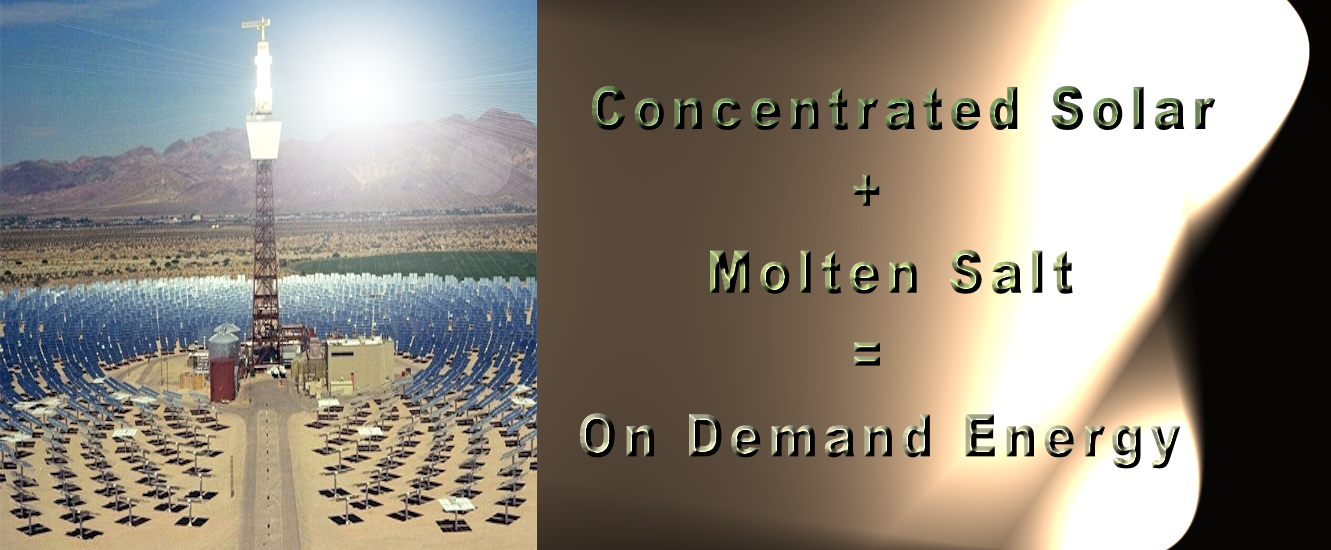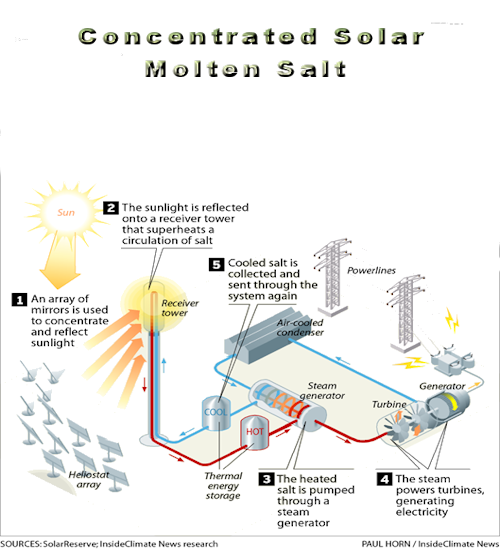
Power From Salt (Concentrated Solar Power)
Osmotic power, salinity gradient power or blue energy is the energy available from the difference in the salt concentration between seawater and river water. Two practical methods for this are reverse electrodialysis (RED) and pressure retarded osmosis (PRO). Both processes rely on osmosis with membranes.
There are a number of methods for producing energy from salt:
- Pressure-retarded osmosis
- Reversed electrodialysis
- Capacitive method
- Vapor pressure differences: open cycle and absorption refrigeration cycle (closed cycle)
- Solar pond
- Boron nitride nanotubes
- Using low caloric waste energy by regenerating a high solution ammonium bicarbonate in a solution with a low salinity
Concentrated Solar And Molten Salt
SolarReserve is trying to prove that the technology that drives Crescent Dunes can make solar power an affordable, carbon-free, day-and-night energy source, dispatched on the electric grid like any fossil fuel plant. Here, concentrated sunlight heats molten salt to 1,050 degrees Fahrenheit in that shimmering tower; then the salt gets stored in a giant insulated tank and can be tapped to make steam to run a turbine.
If this plant and several similar facilities under construction, or soon to be, prove reliable, the technology is poised to take off. Solar photovoltaic (PV) panels can displace fossil fuels during the day, and wind turbines can do the same as long as it's windy. But molten salt towers may be able to meet the challenge of electricity on demand, and push more older, dirtier fossil-fuel plants into retirement.
The advantage of this type of solar energy is the constant generation of power generated from the molten salt. Once the salt is melted it continues to generate heat and energy long after the sun goes down making it a on demand energy source.
This technology is coming into it's own and there are several new plants being built in California and Nevada. Currently there are 20+ plants worldwide with another 20+ being built.
How It Works (The Basics)
The mirrors are called heliostats because each one can tilt and turn to precisely point its beam of light. Arranged in concentric circles, they focus sunlight on the "receiver" at the top of the central tower. Tourists' assumptions aside, this is not actually a light. The receiver, matte black when there's no sunlight on it, absorbs energy to heat the molten salt flowing through a series of pipes. Hot salt then flows down to a stainless steel storage tank.
The salt, heated to this intensity flows like lava or a river, it then runs through a heat exchanger to make steam to run a standard turbine generator. The size of the storage tank holding the molten salt determines the length of time that the energy is stored (3.5 million gallon tank will store 10 hours or 1,100 megawatt hours of storage) or nearly 10 times more than the largest lithium-ion battery systems that have been installed to store renewable power.

Environmental Concerns
In several CSP molten salt power stations there is great concern about the birds who fly over the solar arrays and get fried by the intense heat. These concerns are being addressed but not yet resolved.



